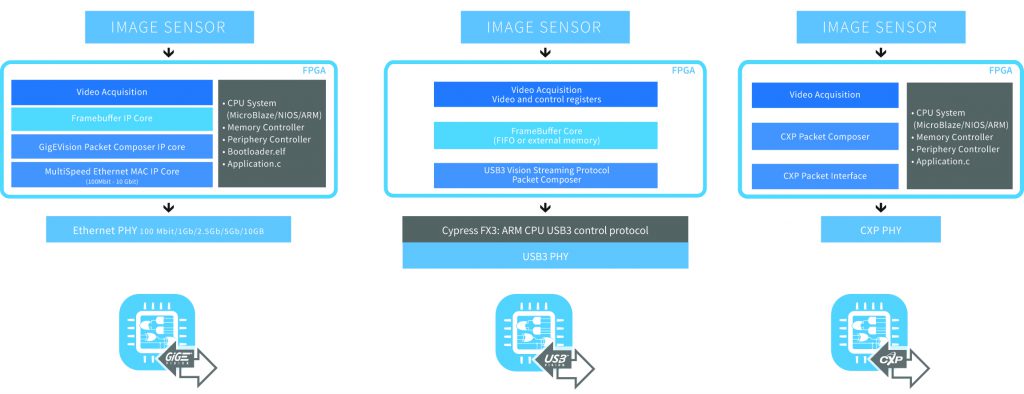Easy Interfaces
Reduce Time to Market with Transport Layer IP Cores
Several months of work by protocol engineers is typically required to design an interface for a vision system. A number of vision camera manufactures, such as Ozray, Crevis and Sick, are addressing this challenge by purchasing transport layer interfaces in the form of intellectual property (IP), which is provided ready to incorporate into FPGAs along with other camera features.
 Bild: Euresys s.a.
Bild: Euresys s.a.A decade ago, Camera Link was the most widely used machine vision transport layer interface. The streaming part of Camera Link was well defined, but the control path was not specified, so every camera implemented its own configuration protocol, requiring individual tweaks on host side to fully support the camera. Bild: Euresys s.a.
Bild: Euresys s.a.
 Image: Euresys s.a.
Image: Euresys s.a.Happy Camera Suppliers
Ozray is a Korean machine vision camera supplier that has implemented IP cores in its area, line scan and thermal cameras. Keith Ahn, Executive Director and CTO, said that in-house development of CXP and GigE transport layer interfaces would have been considerably more expensive than purchasing IP. "By purchasing IP cores, we can focus internal engineering resources on image processing and controlling sensor functions to a degree that wasn't possible in the past when so many resources were devoted to the camera-host interface," Crevis is a leading supplier of machine vision cameras and industrial controllers at Korea. Crevis CEO June Hwang said that in the past it took a considerable amount of engineering manpower to develop the internal transmission logic, device drivers and Tx/Rx library for transport layer interfaces for its area scan cameras. "Now we purchase IP cores for GigE, CXP and USB interfaces from S2I while our engineers focus on developing sensor interface and camera functionality. S2I provides the reference design, training and technical support. This approach makes it possible to develop a reliable standard transmission interface in a fraction of the time required in the past. By incorporating IP cores into an FPGA that replaces many other parts, we have also reduced the size and manufacturing cost of our cameras." Sick's Ranger 3 camera offers a greater number of 3D profiles per second in combination with a large height range and high image quality. "Previous generations of the Ranger 3 used a proprietary GigE interface in order to provide capabilities that could not be delivered by following the standard," said Mattias Johannesson, Senior Expert, Software 3D Camera for Sick IVP. "When the standard grew to include the features we needed, we wanted to adopt it but didn't want to divert the engineering resources that would have been required to do the job internally. S2I offered a proven standard IP Core together with new custom modules to cover the extensions of the standard. Our engineering team was able to focus on our imager and signal processor, making it possible to get the latest Ranger 3 version to market in considerably less time than would have been required if we had developed the interface in-house."
Several months of work by protocol engineers is typically required to design an interface for a vision system. A number of vision camera manufactures, such as Ozray, Crevis and Sick, are addressing this challenge by purchasing transport layer interfaces in the form of intellectual property (IP), which is provided ready to incorporate into FPGAs along with other camera features.
 Bild: Euresys s.a.
Bild: Euresys s.a.A decade ago, Camera Link was the most widely used machine vision transport layer interface. The streaming part of Camera Link was well defined, but the control path was not specified, so every camera implemented its own configuration protocol, requiring individual tweaks on host side to fully support the camera. Bild: Euresys s.a.
Bild: Euresys s.a.
Euresys s.a.
Dieser Artikel erschien in inVISION 1 (März) 2020 - 17.03.20.Für weitere Artikel besuchen Sie www.invision-news.de

































































